SuperOxide
Hazard to Others
  
Posts: 486
Registered: 24-7-2019
Location: Devils Anus
Member Is Offline
|
|
"Fixing" some sodium acetate after a poor dehydration attempt.
I'm working on making some anhydrous sodium acetate using vinegar and baking soda (nothing too ground breaking - sorry). I'm familiar with the
reaction, and followed some decent online tutorials that show how to produce the decently pure sodium acetate trihydrate (such as this video by JBSC), and I think I followed it pretty well. The trihydrate crystals were nice and clear (no color), and washed multiple times with
very cold 100% IPA. Here's a picture of the crystals in a dish just before putting them in the oven:
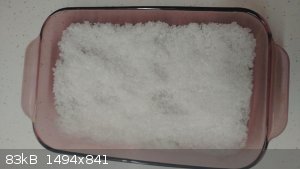
Then after that, I followed the steps in sodium acetate dehydration video by Dougs Lab, and it seemed to be going well, but when I went to check on it one time I noticed it was turning
more yellow than in his videos, and there was considerably more liquid than I expected (I should have taken a picture of that, but I didn't), so I
took it out of the oven to see if it could be saved.
Here's the picture of the yellowing sodium acetate after it's cooled down:
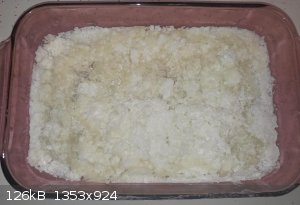
I probably should have done a smaller amount to make sure that the oven was at the right temperature (even though it was at the same temp that Doug
said - 300F, but my oven is slightly dodgy).
After doing a little more research (that I probably should have done before), I found this thread that mentions adding some concentrated H2O2 before boiling the whole thing down (which I didn't boil it, I let it crystalize over
about a week, sometimes heating it slightly for an hour or so a few times a day to speed it up, but never boiled it down) seemed to help the purity of
the end product.
My questions - Is there a way to save this right now? Can I possibly re-dissolve the product in some water, then add the proper amount of concentrated
H2O2 to said solution and proceed from there?
Any input is appreciated - Thanks in advance.
P.S. If this seems like a re-post, then I do apologize. I didn't post in the science madness thread listed above because it's a few years old and I
sometimes get shit for reviving old threads, and my question is more on saving a batch rather than processing a whole new one.
|
|
|
teodor
National Hazard
   
Posts: 872
Registered: 28-6-2019
Location: Heerenveen
Member Is Offline
|
|
SuperOxide, I think it depends on intended usage of the acetate and your lab capabilities. Working with organic substances always include different
purification steps which you can learn and get many benefits. Most basic operation for purification is distillation. Some time ago I made some sodium
acetate from vinegar which was yellow-brown and had a bad smell. After addition of H2SO4 I was able to distil quite pure concentrated acetic acid from
that, which can be used to make more pure sodium acetate. H2O2 is not a common purification method, also I think I tried it but it didn't work well.
Another method of purification of solid substances is re-crystallisation.
[Edited on 12-10-2020 by teodor]
[Edited on 12-10-2020 by teodor]
|
|
|
SuperOxide
Hazard to Others
  
Posts: 486
Registered: 24-7-2019
Location: Devils Anus
Member Is Offline
|
|
Quote: Originally posted by teodor  | SuperOxide, I think it depends on intended usage of the acetate and your lab capabilities. Working with organic substances always include different
purification steps which is good to learn. Most basic operation for purification is distillation. Some time ago I made some sodium acetate from
vinegar which was yellow-brown and had a bad smell. After addition of H2SO4 I was able to distil quite pure concentrated acetic acid from that, which
can be used to make more pure sodium acetate. H2O2 is not a common purification method, also I think I tried it but it didn't work well.
Another method of purification of solid substances is re-crystallisation.
[Edited on 12-10-2020 by teodor] |
I see. Thank you for your reply.
I was thinking about just breaking this up and recrystallizing it. Are there any undesired chemicals that form when the sodium acetate is melted and
yellowed a bit like in my pictures? Or should I be fine if I just re-dissolve it all in hot water and let it recrystallize out slowly?
|
|
|
Corrosive Joeseph
National Hazard
   
Posts: 915
Registered: 17-5-2015
Location: The Other Place
Member Is Offline
Mood: Cyclic
|
|
Purification of Sodium Acetate - Taken from Armarego and Chai (Purification of Laboratory Chemicals) (2003)
/CJ

Being well adjusted to a sick society is no measure of one's mental health
|
|
|
teodor
National Hazard
   
Posts: 872
Registered: 28-6-2019
Location: Heerenveen
Member Is Offline
|
|
Quote: Originally posted by SuperOxide  | | Are there any undesired chemicals that form when the sodium acetate is melted and yellowed a bit like in my pictures? Or should I be fine if I just
re-dissolve it all in hot water and let it recrystallize out slowly? |
I think they are some impurities which were present in the vinegar itself, not the decomposition products, at least my experience suggests that.
I never tried to recrystallise sodium acetate, as far as I know it has tendency to form supersaturated solutions in water. So you should pay attention
to the suggestion of Corrosive Joeseph - try to use alcohol as a solvent or at least alcohol-water mixture. And share your result.
[Edited on 12-10-2020 by teodor]
|
|
|
Morue
Harmless

Posts: 11
Registered: 3-4-2020
Location: Canada
Member Is Offline
|
|
Quote: Originally posted by teodor  |
I never tried to recrystallise sodium acetate, as far as I know it has tendency to form supersaturated solutions in water. So you should pay attention
to the suggestion of Corrosive Joeseph - try to use alcohol as a solvent or at least alcohol-water mixture. And share your result.
[Edited on 12-10-2020 by teodor] |
Yes, recrystallization of sodium acetate from water is not a very good option. It does has a very high tendency to form supersaturated solutions. But
the main issue for me is its solubility in water which is very high, even a low temperatures (about 40g/100ml). So you end up losing a lot of product
each time. Recrystallization from aqueous EtOH seems a better option, as stated above. I assume a mixture of isopropanol-water would also work.
[Edited on 12-10-2020 by Morue]
|
|
|
SuperOxide
Hazard to Others
  
Posts: 486
Registered: 24-7-2019
Location: Devils Anus
Member Is Offline
|
|
Quote: Originally posted by teodor  |
I think they are some impurities which were present in the vinegar itself, not the decomposition products, at least my experience suggests that.
I never tried to recrystallise sodium acetate, as far as I know it has tendency to form supersaturated solutions in water. So you should pay attention
to the suggestion of Corrosive Joeseph - try to use alcohol as a solvent or at least alcohol-water mixture. |
It does form a supersaturated solution, that's for sure, but I was able to get some pretty clean crystals using just water as the solvent (just had to
let it crystalize out slowly... Like... really freakin slowly.. lol), then used the cold IPA to wash the crystals, which seemed to work pretty well.
Here are some pics:
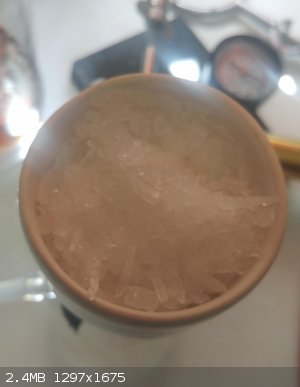 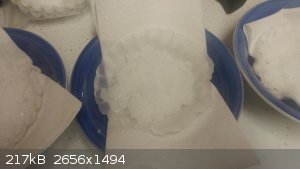
Will do!
|
|
|
teodor
National Hazard
   
Posts: 872
Registered: 28-6-2019
Location: Heerenveen
Member Is Offline
|
|
Nice crystals. Also I noticed that the solubility of magnesium and calcium acetate are much lower than that of sodium, so possible addition of MgSO4
or CaCl2 solution to not-too concentrated NaCH3COO can cause a nice precipitation of pure magnesium/calcium acetate - and then you can convert it back
to sodium with e.g. Na2CO3. But it is just my speculation, I have no time to try it now.
[Edited on 13-10-2020 by teodor]
[Edited on 13-10-2020 by teodor]
|
|
|
XeonTheMGPony
International Hazard
    
Posts: 1636
Registered: 5-1-2016
Member Is Offline
Mood: No Mood
|
|
I gave a good write up on purification of it some where here.
|
|
|
SuperOxide
Hazard to Others
  
Posts: 486
Registered: 24-7-2019
Location: Devils Anus
Member Is Offline
|
|
Quote: Originally posted by teodor  | | Nice crystals. Also I noticed that the solubility of magnesium and calcium acetate are much lower than that of sodium, so possible addition of MgSO4
or CaCl2 solution to not-too concentrated NaCH3COO can cause a nice precipitation of pure magnesium/calcium acetate - and then you can convert it back
to sodium with e.g. Na2CO3. But it is just my speculation, I have no time to try it now. |
Thank you! They took a fricken week to grow... lol
And nice idea! I'll give it a shot, maybe on a smaller scale or on a portion of a larger batch, just to have another solution as the control.
|
|
|
SuperOxide
Hazard to Others
  
Posts: 486
Registered: 24-7-2019
Location: Devils Anus
Member Is Offline
|
|
Was able to do a recryst with some good ol fashioned H2O. I know some of you recommended using ethanol with water, but I figured I got
decent results using just water before.
But it looks like it worked out well. Don't see any of the brown/yellow color of the burnt sodium acetate, and the crystals actually look even better
than they did before.
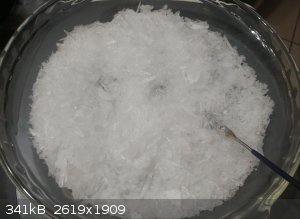 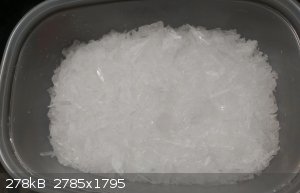
Now the next step is to convert it to the anhydrous form, without screwing it up again.. lol. I know someone supplied some much more in-depth
instructions on the process, which I will be sure to follow (maybe a test run with a smaller amount, instead of risking the whole batch, again..).
Thanks guys!
[Edited on 18-10-2020 by SuperOxide]
|
|
|
SuperOxide
Hazard to Others
  
Posts: 486
Registered: 24-7-2019
Location: Devils Anus
Member Is Offline
|
|
Quote: Originally posted by Morue  |
Yes, recrystallization of sodium acetate from water is not a very good option. It does has a very high tendency to form supersaturated solutions. But
the main issue for me is its solubility in water which is very high, even a low temperatures (about 40g/100ml). So you end up losing a lot of product
each time. Recrystallization from aqueous EtOH seems a better option, as stated above. I assume a mixture of isopropanol-water
would also work. |
When you say aqueous EtOH, what percentage would you recommend be used? Or does it even matter?
[Edited on 19-10-2020 by SuperOxide]
|
|
|
teodor
National Hazard
   
Posts: 872
Registered: 28-6-2019
Location: Heerenveen
Member Is Offline
|
|
Well, usually this technology could be used: just add the ethanol (85-95%) to a concentrated aqueous solution and see whether crystals are formed by
this action. It is not worth to add more than equal volume of ethanol as that of the water solution and very often good results could be achieved with
lesser quantity.
But it works only when the salt is insoluble or pure soluble in ethanol.
Edit: for the special purpose of purification the crystals could be digested with 90-85% ethanol. Actually concentration should be adjusted so that
most part of salt should not dissolve - and it will dissolve more easier if the ethanol has lesser concentration. So, for the purification it is worth
to try as dilute ethanol as possible - it should dissolve salt only by a little, keeping the product and taking off all the impurities.
The last method could work, for example, for your "dirty" salt.
[Edited on 19-10-2020 by teodor]
|
|
|
SuperOxide
Hazard to Others
  
Posts: 486
Registered: 24-7-2019
Location: Devils Anus
Member Is Offline
|
|
So I was able to dehydrate it just fine this time. I went about it in a slightly more cautious manner (first dehydrating a 10g sample, then 40g), and
it lost almost exactly the weight I expected it to lose.
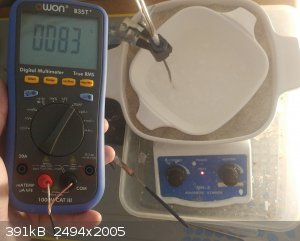
The resulting anhydrous sodium acetate powder looks pretty clean though it's slightly off white, but only really noticeable on a white
surface. But still... kinda irritating >_<
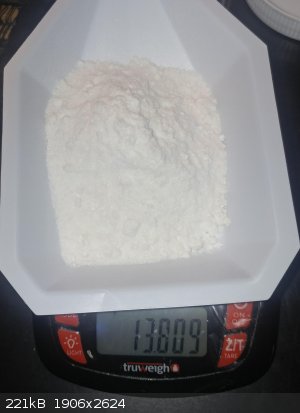
So I may try to recrystallize the sodium acetate.... again... Using the recommended procedures above (ethanol or IPA, instead of just H2O, as the
water takes forever to get nice crystals out).
Or... I may take the lazy route and accept the slightly off white powder, lol.
Anyways - Thanks for the input guys! Much appreciated, seriously.
|
|
|
SuperOxide
Hazard to Others
  
Posts: 486
Registered: 24-7-2019
Location: Devils Anus
Member Is Offline
|
|
Deleted - Since I'm pretty sure I found the answer for the question I posted here, and just feel silly for having posted it :-P
[Edited on 21-10-2020 by SuperOxide]
|
|
|
Morue
Harmless

Posts: 11
Registered: 3-4-2020
Location: Canada
Member Is Offline
|
|
Quote: Originally posted by SuperOxide  | Quote: Originally posted by Morue  |
Yes, recrystallization of sodium acetate from water is not a very good option. It does has a very high tendency to form supersaturated solutions. But
the main issue for me is its solubility in water which is very high, even a low temperatures (about 40g/100ml). So you end up losing a lot of product
each time. Recrystallization from aqueous EtOH seems a better option, as stated above. I assume a mixture of isopropanol-water
would also work. |
When you say aqueous EtOH, what percentage would you recommend be used? Or does it even matter?
[Edited on 19-10-2020 by SuperOxide] |
It's hard to say without proper data from experiments. I found this paper for 1-propanol and methanol : https://doi.org/10.1021/je400625f. (Use sci-hub to download it). Based on this paper, a 30% mixture of 1-propanol and water decreases the
solubility of sodium acetate by a factor of 5 at 25C, approximately. I would try using as little alcohol as possible in your mixture as your
impurities are probably from residual sugars coming from the vinegar, which are insoluble in alcohols.
[Edited on 22-10-2020 by Morue]
|
|
|
Texium
Administrator
       
Posts: 4508
Registered: 11-1-2014
Location: Salt Lake City
Member Is Offline
Mood: PhD candidate!
|
|
@SuperOxide: I think that the nearly white anhydrous sodium acetate that you've obtained should be of excellent quality for amateur chemistry
experiments. Well done! Just curious, what was your overall yield, if you know?
|
|
|
SuperOxide
Hazard to Others
  
Posts: 486
Registered: 24-7-2019
Location: Devils Anus
Member Is Offline
|
|
Quote: Originally posted by Texium (zts16)  | | @SuperOxide: I think that the nearly white anhydrous sodium acetate that you've obtained should be of excellent quality for amateur chemistry
experiments. Well done! Just curious, what was your overall yield, if you know? |
Thanks! It definitely seems pretty white, and should be sufficient.
Re the yield - I started off keeping track of everything I was using (just vinegar and baking soda) so I could calculate the yield, but in the process
of learning and fixing some screw ups, I lost track. So not quite, but since I have the process down to pat, I think I may do another batch, which I
definitely will calculate the yield. I will update this thread after that's done :-)
Edit: And now that I have it put inside its container and am taking a closer look, I think some of the color may be a sign of it not being completely
dry. I planned on crushing it up and baking it in an oven on higher temp for longer, so that will likely help.
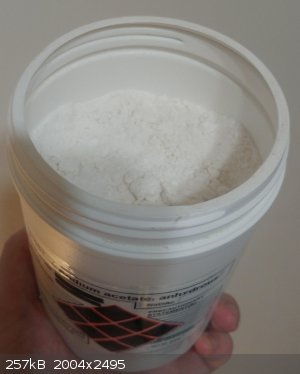
[Edited on 23-10-2020 by SuperOxide]
|
|
|
teodor
National Hazard
   
Posts: 872
Registered: 28-6-2019
Location: Heerenveen
Member Is Offline
|
|
@SuperOxide you've got a nice label! I still use hand-written marks with felt-pen, shame on me.
|
|
|
SuperOxide
Hazard to Others
  
Posts: 486
Registered: 24-7-2019
Location: Devils Anus
Member Is Offline
|
|
Haha, thanks! I use some GHS Labels from Amazon and a nifty label printer. Though it was slightly silly to use it for sodium acetate because none of the hazard pictograms
were needed, but I just thought it would look out of place if it was the only chemical container without that kind of label.
|
|
|
draculic acid69
International Hazard
    
Posts: 1371
Registered: 2-8-2018
Member Is Offline
|
|
Quote: Originally posted by SuperOxide  | Quote: Originally posted by teodor  | SuperOxide, I think it depends on intended usage of the acetate and your lab capabilities. Working with organic substances always include different
purification steps which is good to learn. Most basic operation for purification is distillation. Some time ago I made some sodium acetate from
vinegar which was yellow-brown and had a bad smell. After addition of H2SO4 I was able to distil quite pure concentrated acetic acid from that, which
can be used to make more pure sodium acetate. H2O2 is not a common purification method, also I think I tried it but it didn't work well.
Another method of purification of solid substances is re-crystallisation.
[Edited on 12-10-2020 by teodor] |
I see. Thank you for your reply.
I was thinking about just breaking this up and recrystallizing it. Are there any undesired chemicals that form when the sodium acetate is melted and
yellowed a bit like in my pictures? Or should I be fine if I just re-dissolve it all in hot water and let it recrystallize out slowly?
|
Yes There is decomposition products formed. I made sodium acetate a few times and once I left it on overnight and it decomposed a bit.if U watch the
video of nitroethane synthesis on nuxs channel on YouTube when he pours the powder out of his metal rxn thingy the decomp products looked exactly the
same. Watch from 3:35 https://m.youtube.com/watch?v=GWVoJDNlLLY
|
|
|
SuperOxide
Hazard to Others
  
Posts: 486
Registered: 24-7-2019
Location: Devils Anus
Member Is Offline
|
|
Quote: Originally posted by draculic acid69  | Quote: Originally posted by SuperOxide  | Quote: Originally posted by teodor  | SuperOxide, I think it depends on intended usage of the acetate and your lab capabilities. Working with organic substances always include different
purification steps which is good to learn. Most basic operation for purification is distillation. Some time ago I made some sodium acetate from
vinegar which was yellow-brown and had a bad smell. After addition of H2SO4 I was able to distil quite pure concentrated acetic acid from that, which
can be used to make more pure sodium acetate. H2O2 is not a common purification method, also I think I tried it but it didn't work well.
Another method of purification of solid substances is re-crystallisation.
[Edited on 12-10-2020 by teodor] |
I see. Thank you for your reply.
I was thinking about just breaking this up and recrystallizing it. Are there any undesired chemicals that form when the sodium acetate is melted and
yellowed a bit like in my pictures? Or should I be fine if I just re-dissolve it all in hot water and let it recrystallize out slowly?
|
Yes There is decomposition products formed. I made sodium acetate a few times and once I left it on overnight and it decomposed a bit.if U watch the
video of nitroethane synthesis on nuxs channel on YouTube when he pours the powder out of his metal rxn thingy the decomp products looked exactly the
same. Watch from 3:35 https://m.youtube.com/watch?v=GWVoJDNlLLY |
Well I think the yellow that formed in mine was just because I didn't let it finish. I mean I kept it around 175 °C (got there slowly), and it never
got over 220 °C (which it wasn't there for long).
I do have a question though - I see some articles that say you should basically heat it until it melts (324 °C), then pour it on a metal pan and let
it cool down, then crack it up. Then I see others that say if you heat it too hot, it decomposes (and "chars")...
How can it decompose at temperatures below its melting point?
[Edited on 24-10-2020 by SuperOxide]
|
|
|